
November 2011

New @ FOA FOA Corporate Memberships Fiber U - two new free online self-study courses Publications: NECA/FOA 301 Installation Revised, eBooks Online Reference Guide: Many new pages Tech Topics: More online information Certification: New FOA OSP Certification FOA Schools: New schools and programs, Training in Hawaii FOA Jobs Web Site
AFL to Host "Traveling" Advanced Splicing Seminars Q&A: Large number of good questions this month, e.g. IR/UV Eye Protection Product News - New handheld OTDRs, FO coil cords Worth Reading:
Last Month In The FOA Newsletter:
|
It's now CFOT® and Fiber U® The FOA CFOT® (Certified Fiber Optic Technician) and Fiber U® (the FOA online self-study program) are now a registered trademark. With over 33,000 fiber optic techs holding CFOTs and the CFOT being recognized worldwide as the foremost certification in fiber optics, the FOA realized the value of the CFOT and Fiber U required trademark protection. Now it's official! Want to know more about fiber optics? Free Self-Study Program on "Fiber U®." Looking for specific information? Study for FOA certifications? Here's the largest technical reference on the web: The FOA Online Fiber Optic Reference Guide. New FOA Reference Books(Available Printed or eBooks)
|
| Renew your FOA certification online - plus get a discount coupon for the new FOA books and an extra month free. Details here. |
There is still time to sign up for our seminars in New Zealand, Australia and Malaysia. See directions here. There is a new free FOA app for iPhone/iPad/iPodtouch users - a loss calculator app. More details here. There is another new FOA YouTube video, this one is on FTTH. Go to the FOA channel to view it. Are You In The South Pacific? Come Meet The FOA! After our enthusiastic reception in Turkey and Africa, we've had invitations to visit other areas and present our "What's New In Fiber" seminars. Our next trip is to the South Pacific area - Australia, NZ and Malaysia - in November. 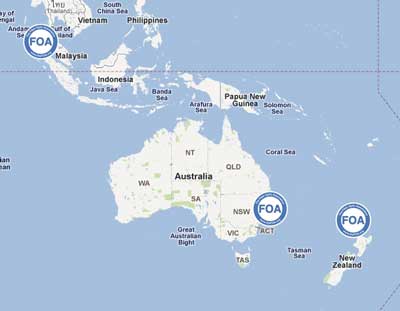 FOA “What’s New In Fiber Optics” Seminar The FOA will present its “What’s New In Fiber Optics” seminar in New Zealand, Australia and Malaysia in November, 2011. As the international professional society of fiber optics with over 200 affiliated training organizations in 40 countries, the FOA must keep abreast of new fiber optic technology and communications applications. This FOA seminar will provide an overview of the some of most interesting new developments in fiber optics. In addition, the FOA will invite other local speakers to talk about their work. The FOA has held these seminars in other parts of the world where they have very successfully created an opportunity for attendees to learn more about the latest fiber optic technology and what is happening in their local markets. In addition, it is an opportunity to meet FOA personnel and ask questions about topics of interest. Jim Hayes, President of the FOA, will speak for the FOA. Jim was trained as an astronomer and physicist, was one of the earliest entrepreneurs in fiber optics and has been training in fiber optics since 1982. In 2001, Jim was selected as one of the “Luminaries” of fiber optics and in 2007 as one of the “Pioneers” of FTTP. Jim was one of the founders of the FOA and is the technical editor of the FOA publications and website. Last Chance to Register! The current seminar schedule is below. Information will be sent to all registered participants well in advance of the meeting. November 10, Auckland, NZ, Waipuna Auckland Hotel & Conference Centre, 9:30AM-2 PM, a few seats are still available, to register contact Gavin Bowden at <gavin@etec.ac.nz> FOA “What’s New In Fiber Optics” seminars are free - you even get a free copy of the FOA Reference Guide to Fiber Optics. If you are interested in attending the FOA "State of Fiber Optics" seminar and meeting FOA personnel, sign up here. All details of the seminar will be emailed to you.  FOA President To Speak At NZ "Rural Broadband Symposium" While in New Zealand for the FOA “What’s New In Fiber Optics” seminar, FOA President Jim Hayes has been invited to speak to the Telecommunications Users Association of New Zealand's symposium on bringing broadband to rural areas in NZ. Jim will present on "rural broadband – a worldwide perspective" : Every country is trying to bring broadband to rural areas where technology and economics collide. What's feasible? We will look at what is happening from our base in the US and in areas we have visited around the world. Read more. Learn More About Australia's National Broadband Network Here is a YouTube Video of a lecture Peter Ferris, GM Network Planning & Design, NBN, gave recently at MacquarieUniversity in Sydney. Peter Ferris is the man responsible for the design and planning of the network for the National Broadband Network (NBN). Ferris describes NBN's plans to connect 93 per cent of all Australian premises with broadband services with speeds up to 100 Mb/s, and all other premises in Australia with next generation wireless and satellite technologies that will deliver speeds up to 12 Mb/s. It's almost an hour long, but well worth a view! http://www.youtube.com/watch?v=6a2ne1WKxek Fiber Vs Copper For Premises Networks? Think Again! "A survey by WLAN vendor Meraki in June found that for the first time smartphones and tablets like the Apple iPhone and iPad have overtaken computers on Wi-Fi networks. The finding highlights the argument over how much wired LAN infrastructure companies need, or should have when users' connection expectations are for reliable wireless. Colleges and universities that spent over a decade and a ton of money running Ethernet cables to dorm room (“a port for every pillow”) now discover that 50% to over 90% of those wired ports are never used. One university IT staffer said most students wouldn’t even know what to do with a patch cable. John Cox, Network World, Nov. 2, 2011 We've been saying this for years - while copper and fiber were battling for desktop supremacy, wireless has become the connection of choice. Now that the majority of devices sold, smartphones and tablets, don't have wired connections as an option, the future of structured cabling in the horizontal is in doubt. Since we sit on some of the committees that write TIA-568, we were curious about what all the documents say about wireless. It's practically nothing. Fiber continues to be used in backbones and to connect wireless APs (access points) especially in metropolitan areas, but all that "Cat 5" to the desktop may be best used by recycling for the value of the copper. More New Lectures on  A new FOA lecture on fiber to the home, etc. - FTTx - is now online, making 25 lectures total. The lectures added last month include nine lectures covering all aspects of fiber optic testing plus lectures with visual demonstrations on Total Internal Reflection and Modes in Multimode Fiber (with a demonstration of the effects of a mandrel wrap mode conditioner and use of a Visual Fault Locator. Below is a list of the current lectures (plus there are 28 hands-on videos too!). We're looking for ideas for topics for future lectures. Send your ideas to <info@thefoa.org>. View the FOA YouTube video Lectures. Benchmarking Fusion Splicing We've been asked many times "How long does it take to splice a cable?" It's not a simple answer as it varies with the number of fibers in the cable and the work setup, including whether one or two techs are working at a job site. FOA Master Instructor Joe Botha of Triple Play in South Africa did his own analysis based on decades of experience both splicing cables and teaching others how to do it properly. This is one of the best analyses we have seen because Joe includes prep times as well as splicing times and differentiates between one tech and two techs working together. He adds some other tips on fusion splicing too. This should be mandatory reading for every tech and given to every student! Here is Joe's analysis. (PDF, 350 kB) Installing a University/Metro Network Using Microtrenching and Air-Blown Fiber The fibre system at OCAD U in Toronto was designed and installed for Metro Fibrewerx by Connectivitywerx, an affiliated company. The fibre network for OCAD U is part of an overall high capacity Metropolitan Area fibre network composed of several rings that Metro Fibrewerx is deploying in downtown Toronto. The ducts and fibre cables were selected for compatibility with one another and with the “ Breeze” air blower provided by General Machine Products (GMP Inc.)of Trevose , Pennsylvania. 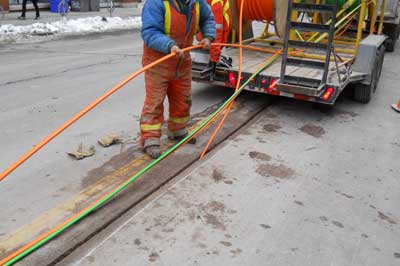 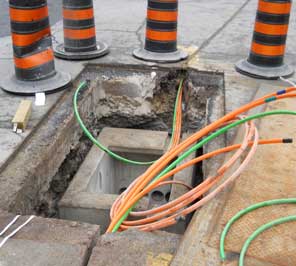 Read the entire story about this project in last month's FOA Newsletter. New Edition of Eric Pearson's Book: Professional Fiber Optic Installation, The Essentials For Success  Pearson Technologies Inc. announces the release of Professional Fiber Optic Installation, The Essentials For Success. This text provides all the information necessary to achieve the four goals of installation: low power loss, low installation time, low installation cost, and high reliability. This text contains the knowledge, methods, and procedures necessary to successfully install, test, and inspect fiber optic cables, connectors, and splices. Based on 31 years of experience, laboratory testing, development, and training of more than 8000 installers, this text is suitable for training, installation, personnel certification, and reference. To its predecessor, Revision 7.2, this text adds material on EF testing, bend insensitive fibers, chromatic and polarization mode dispersion testing, and changes introduced by TIA/EIA-568-C. Finally, this text and three of its appendices enable personnel certification to all seven Fiber Optic Association (FOA) certifications from CFOT to CFOS. With 352, 8.5x11 inch pages, 27 chapters, 527 figures, 57 tables, and 407 review questions, this comprehensive yet concise, text takes the novice installer to the professional knowledge level rapidly. Available on 10/12 for $49 plus shipping and handling. Update: Eric has also released "Mastering The OTDR" a complete book that covers exactly what the title says. For additional information. contact Pearson Technologies Inc., www.ptnowire.com, fiberguru@ptnowire.com, 770-490-9991 Events of Interest FOA “What’s New In Fiber Optics” Seminar (more details above) November 10, Auckland, NZFOA “What’s New In Fiber Optics” seminars are free. If you are interested in attending the FOA "State of Fiber Optics" seminar and meeting FOA personnel, sign up here. All details of the seminar will be emailed to you. AFL to Host "Traveling" Advanced Splicing Seminars AFL has launched advanced splicing seminars intended for engineers and professionals, as well as university students, engaged in fiber optic activities involving non-standard and specialty fusion splicing activities. Typical applications for these advanced splicing needs are often in the Medical, Oil and Gas, Fiber Lasers, Optical Manufacturing, and Aerospace markets. These seminars will cover a wide range of applications and solutions for difficult and challenging applications using advanced fusion splicing platforms.
Free Corning "See the Light" Seminars Corning Cable Systems' See the Light team is coming to a city near you! Receive Free fiber optic training on a variety of topics including Termination Technology, Testing and Trouble Shooting, Fusion Splicing, and Preterminated Solutions. These interactive three-hour sessions provide students with a comprehensive overview of the latest technology. Fiber optic BICSI (CEC) credits apply (3). Here is the current schedule. For more information email the See the Light Team at STLinfo@corning.com.  What's New @ FOA What's New @ FOA
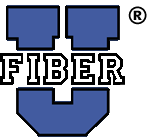 Two New Free Fiber U Self-Study Programs on Outside Plant Fiber Optics and OTDRs There are two new free online self-study programs on Fiber U. "Outside Plant Fiber Optics" uses the new FOA textbook and online reference guide to OSP to help you learn about OSP fiber networks. The "Understanding OTDRs" self-study program will help you learn how to properly use these complicated instruments and there is a free OTDR simulator you can download to use for practice. FOA Certification On Outside Plant Fiber Optics The new FOA CFospT outside plant certification focuses on OSP fiber optic network design, installation and maintentance. A CFospT certified tech must know the ways that fiber is used in the OSP, how it is installed, tested and maintained. While a CFOT might only have a basic knowlede of fusion splicing and OTDR testing, for example, a CFospT will be knowledgeable and skillful in those areas - and more. Reference materials for the new CFospT are the printed textbook, the FOA Reference Guide to Outside Plant Fiber Optics (right) as well as eBooks from Amazon for the Kindle or Apple for the iPad/iPod/iPhone and the OSP reference section of the FOA Online Reference Guide which now includes a self-study guide to the CFospT exam. More information on the FOA Outside Plant Fiber Optic Technician (CFospT) certification. Want to know more about OSP? There's OSP Magazine.
   We have created three new FOA books to be used in training for FOA certifications and as reference books for contractors, installers and end users of fiber optics. These books have full curriculum support, including free curriculum materials for teaching FOA certification courses. Because we are self-publishing these books using more modern "publish on demand" technology, they are easier to keep up to date, easier to buy and much, MUCH cheaper! All are now available in print and electronically in Kindle and Apple iBook versions. The basic fiber optic book is also available as a self-study program in an Apple APP for iPad/iPhone/iPod. Details on the new book each of the new books are at the book pages linked to the photos above. The FOA has just released its second APP for the iPad, a free "loss budget calculator," FOA LossCalc. FOA LossCalc 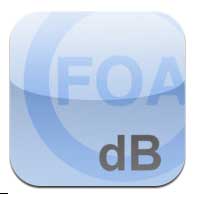 FOA
LossCalc estimates the optical loss of a fiber optic link. This will
save time for the installer of a fiber optic link needing to know
whether test results are reasonable and/or make a "pass/fail"
determination. It can also help the designer of a link to determine if
communications equipment will operate over this link. FOA
LossCalc estimates the optical loss of a fiber optic link. This will
save time for the installer of a fiber optic link needing to know
whether test results are reasonable and/or make a "pass/fail"
determination. It can also help the designer of a link to determine if
communications equipment will operate over this link. By choosing the type of link (singlemode or multimode) and specifying the length of the fiber and numbers of connections and splices, it will calculate the end to end loss of the link. The app has default specifications for singlemode and multimode links or the user may create custom setups with specifications appropriate for any application. http://itunes.apple.com/us/app/foa-losscalc/id476262894?mt=8&ls=1 Self -Study in Fiber Optics  Our first app is a self-study version of the FOA Reference Guide to Fiber Optics. The
FOA APP builds on the FOA basic fiber optic textbook to create an
interactive learning environment that builds on the iBook electronic
version of the book to add a guide to use for self-study and real-time
testing that provides feedback on what you have learned and correct
answers to questions answered incorrectly. Our first app is a self-study version of the FOA Reference Guide to Fiber Optics. The
FOA APP builds on the FOA basic fiber optic textbook to create an
interactive learning environment that builds on the iBook electronic
version of the book to add a guide to use for self-study and real-time
testing that provides feedback on what you have learned and correct
answers to questions answered incorrectly.The FOA APP is priced at only $9.99, same as the iBook, so the self-study program is free. Download it from the Apple APP Store with your iPad or iTunes. http://itunes.apple.com/us/app/foa-guide/id434354283?mt=8&ign-mpt=uo%3D4 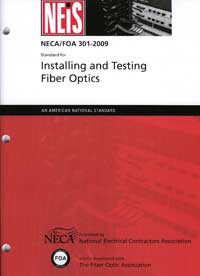 Standards cover components and systems and how to test them, but rarely get into installation issues. The FOA NECA 301 standard which covers installation of optical fiber systems has been revised for the second time, adding considerable new materials. This standard is derived from FOA educational material put in standards form and approved by ANSI as an American National Standard. It's specifically written to be used in contracts to define "installation in a neat and workmanlike manner." The standard is available from NECA. Lectures: 25 Lectures Now Available Plus 28 More Hands-On Videos 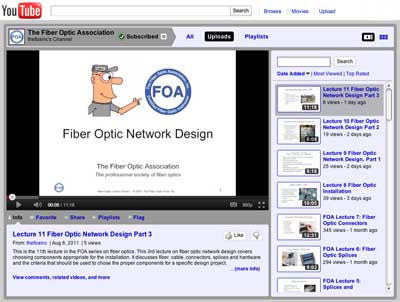 Below is a list of the current lectures (plus there are 28 hands-on videos too!). We're looking for ideas for topics for future lectures. Send your ideas to <info@thefoa.org>. FOA Lecture 1: Fiber Optics & Communications FOA Lecture 2: Safety When Working With Fiber Optics FOA Lecture 3: Optical Fiber FOA Lecture 4: Fiber Optic Cables FOA Lecture 5: Splices and Connectors FOA Lecture 6: Fiber Optic Splices FOA Lecture 7: Fiber Optic Connectors FOA Lecture 8: Fiber Optic Installation FOA Lecture 9: Fiber Optic Network Design, Part 1 FOA Lecture 10: Fiber Optic Network Design Part 2 FOA Lecture 11: Fiber Optic Network Design Part 3 FOA Lecture 12: Fiber Optic Testing Overview FOA Lecture 13: Testing Fiber Visually FOA Lecture 14: Testing Optical Power FOA Lecture 15: Five Ways To Test Fiber Optic Cable Plants FOA Lecture 16: Insertion Loss Testing FOA Lecture 17: OTDR Testing FOA Lecture 18: OTDR Setup FOA Lecture 19: OTDR Measurement Uncertainty FOA Lecture 20: Other Fiber Optic Tests FOA Lecture 21 Visual Fault Locator Demonstration FOA Lecture 22 Mode Power Distribution in Multimode Fibers Demonstration FOA Lecture 23 Total Internal Reflection in Optical Fiber Demonstration FOA Lecture 24 Copper, Fiber or Wireless? FOA Lecture 25 FTTx View the FOA YouTube video Lectures. What's New in the FOA Online Fiber Optic Reference Guide We have been updating the Online Reference Guide to keep up with changes in the industry and adding lots of new pages of technical information. OTDR FAQs Including FOA Master Instructor Terry O'Malley's tests on what the end of a fiber trace looks like with broken and cleaved fibers. Frequently Asked Questions On OTDRS And Hints On Their Use Testing FTTH Basic guidelines for testing FTTH PON networks Measuring Reflectance or Return Loss It can be important but it's not so easy to test. Frequently Asked Questions About OTDRs When do you use them, how to find distance to fault, what effect does end preparation have on traces, more. Encircled Flux What does this new method of measuring mode power distribution in MM fiber mean to testing standards? Fiber Optic and Premises Cabling Project Paperwork Covering what are SOW, RFPs and RFQs and how they are created for a project. Effects of Alignment and Fiber Geometry on Fiber Optic Connector Loss With all the controversy about connector loss due to modal distribution, we sometimes forget the effects of component variations. Fiber Optics For Wireless Networks How wireless is not wireless - it needs fiber. Premises Cabling Installation Installing copper/fiber/wireless for premises networks. Web Page on Bend Insensitive Fiber Bend-insensitive fiber is a "hot topic" now - we try to explain how it works and what it means for installation and test. Basic Fiber Design Section Updated Lots of new materials added to this introduction to fiber optic network design. Web Page on Data Centers Data centers are the heart of the Internet, storing and supplying data for user requests. Needless to say, high performance cabling is needed to move the data between storage, servers and routers. We've created a new pagein our Online Reference Guide on data centers - how fiber and cabling are vital to their performance. Learn More About OTDRs - Download a Free OTDR Simulator More and more installers are being asked for OTDR testing but using these instruments is not easy. They are hard to set up properly and complicated to interpret the traces. Using the autotest function can lead to disastrous results! The FOA has a good tutorial on OTDRs on our Online Reference Guide and we added a free download of an OTDR simulator to the OTDR section so you can learn how to use an OTDR on your PC. OSP Reference Section on the FOA Online Reference Guide website Joining our basic fiber optics and premises cabling sections on the FOA Reference Guide website is a new outside plant reference section that covers materials like that in our new textbook. The material is ready for use and will be followed shortly by a self-study guide. Both the OSP textbook and website are references for the new FOA CFospT outside plant technician certification. More New Info: Links to manufacturers and distributors of fiber optic lighting products. The FOA Online Fiber Optic Reference Guide has become very popular - perhaps the most popular technical website ever, typically with over 270,000 users downloading about 1.6 million pages in 2010! We continue updating materials regularly, keeping it as up to date as possible. Find What You Want Using "Google Custom Search  There's
so much information on the FOA Tech
Topics and Online Fiber Optic Reference Guide
that even a well-organized Table of Contents isn't enough and when the
material is always changing, an index is impossible to maintain. So the
FOA is using the latest technology in search, Google Custom Search,
which will allow you to search just the
FOA Tech
Topics and Online Fiber Optic Reference Guide for
any topic you want to find more about. Try
it! There's
so much information on the FOA Tech
Topics and Online Fiber Optic Reference Guide
that even a well-organized Table of Contents isn't enough and when the
material is always changing, an index is impossible to maintain. So the
FOA is using the latest technology in search, Google Custom Search,
which will allow you to search just the
FOA Tech
Topics and Online Fiber Optic Reference Guide for
any topic you want to find more about. Try
it! Go to The FOA Online Fiber Optic Reference Guide. School News FOA Trains JATC Instructors For 15th Year 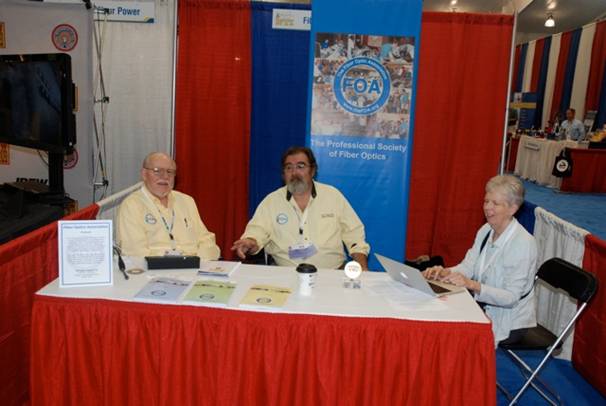  Jim Hayes, Tom Collins and Karen Hayes at the JATC National Training Institute Trade Show. New Schools The FOA welcomes the newest additions to our listing of FOA-Approved Training Organizations: #753- Oerigo Training Institute, Kuwait #754- Advanced Solutions, Trinidad #635- Florida East Coast Electrical & JATC Find a listing of all the FOA-Approved schools here. It's Now A Lot Easier To Find A FOA-Approved Training Organization  Most phone calls we get regarding finding a FOA-Approved training organization want to know two things: what school is closest to me or what school offers the certifications I need. That can be difficult, since the FOA has almost 200 training organizations we have approved worldwide! We've been looking at ways to make it easier, and we think we've got a good solution. In fact we have two solutions. First we have added a sortable table of all the FOA-Approved schools. You can also use our FOA Google Map Application to find FOA-Approved schools. Here are links to the sortable table of all the FOA-Approved schools and FOA Google Map. What Should A Fiber Optics or Cabling Tech Know and What Skills Do They Need? The FOA has been updating its lists of KSAs (Knowledge, Skills, Abilities) for fiber and cabling techs. The updated list is now on the website for your information and comments - as fiber and cabling KSAs evolve as new technologies develop. KSAs for fiber and cabling techs. Good Question! Tech Questions/Comments Worth Repeating Tech Hint: Did You Know You Have A Fiber Optic Tester In Your Pocket? Yes! The camera in your cell phone is sensitive to infrared light - lots more than your eye - and can detect light in an optical fiber or from a transmitter. Chris Hillyer,CFOT/CFOS/I, Master Instructor, Northern California Sound & Communication JATC sent us some photos showing how this works. See below or the video now on YouTube. More On "Encircled Flux" - Maybe The Mandrel Wrap is "Good Enough" IEC 86C/1004/DTR is our for comments and due to be be voted on next Spring, which by standards time is pretty quick! Here is the official description: "IEC/TR 61282-11 Ed. 1.0 Fibre optic communication system design guides - Part 11: Multimode launch conditions This technical report is intended to show the background of encircled flux for the characterisation of multimode launch conditions. This includes the selection of the encircled flux and the definition of the encircled flux requirements in conjunction with the implied variation in attenuation measurements." Lines 490-492 from the draft document say it matches VCSEL launch conditions considered in 10 GbE. Lines 493-395 say it is close to the mandrel wrap mode conditioner used in TIA standards for many years. That is a very useful conclusion. 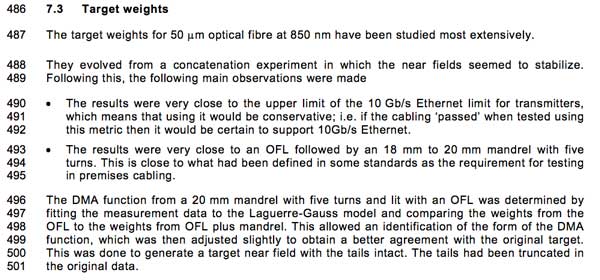 Who Determines The Length Of Fiber A Network Supports? Q: A fiber manufacturer tells me their fiber will support Ethernet over a longer length than the manufacturer of the Ethernet electronics. Who's right? A: Over the last several years, there has been controversy over claims from fiber companies that their fiber will support some network over longer distances than the network standard specifies. It has happened that real world applications have failed to work over these longer distances and the network equipment manufacturers have refused to be held responsible, saying the customer (or the fiber company they trusted) is at fault. When in doubt, we advise users to not exceed the limits of the network standard. An old friend from who later the Ethernet committee at IEEE, used to say that standards are "mutually agreed-upon specifications for product development." It's a quirk of standards that they are "minimum" specifications, so manufacturers always provide product that exceeds the minimum specs of the standards. However, some judgement is required when one ventures outside the limits set by the standards because it may not be acceptable to others building products closer to the minimum specs set in the standards. Separating A Meter And Souce To Test A Cable Plant Q: For a fiber link to be tested between Station A and Station B, you need to position for e.g Light Source at Station A and Power Meter at Station B. Before that both Power Meter and Light Source need to be calibtrated either at Station A or Station B . After successful calibration then you need to carry over Power Meter to Station B. The question is can the Light Source be turned off while waiting for someone to carry over Power Meter to Station B? A: Sources have warm-up times and coupling variability (especially if you change launch cables), meters usually do not. Some sources may vary output with battery condition, so may need to be left running on AC power to be stable. So leave the source at one location and carry the meter to the far location. Test your source for warm-up and variability this way: Set up with a launch cord attached to the source. Let the source warm up for 5 minutes and use the power meter to set the "0 dB" reference. After setting reference for "0 dB," do not remove the launch cable from the source as the coupled power may vary each time a cable is inserted. To see if the source returns to the same value each time, connect a power meter to the end of the launch cable (or leave it connected after setting the "0 dB" reference) and turn the source off, letting it cool down for ~30 minutes, and turn it back on. Take readings with the power meter at turn-on, 1 minute, 2 min, etc until the reading stabilizes. Does it still read the same "0 dB" reference? If it does return to the same value for "0 dB" reference, turning the source on and off is OK. If it takes a few minutes to return to the same value, just note that time and always allow the source to warm-up for that time. If it does not return to the same value, you can either leave it on while you carry the meter to the remote location or use a separate meter to check it (and if the source can be tweaked, change the output value to the level it was at when you checked the "0 dB" reference.) Most crews leave their source on (with AC power connected) all the time when testing. It just sits on a bench and the tech plugs the launch cable into the appropriate ports for testing (being careful to clean and inspect the connector regularly!) while the tech at the other end makes measurements and records the data. Cell phones are good for communicating here - before they became available, we built FO talk sets that used the fibers being tested. If you have 2 meters and 2 sources, you can cross-calibrate them, note the output levels of the source in the other set's meter and work in two locations in two directions. If you have two sources that have adjustable output power, set them to the exact same value before doing your "0 dB" reference calibration. The FOA Online Reference Guide has lots of info on topics like this in the test section: http://www.thefoa.org/tech/ref/contents.html Q: Can You Tell Anything About The End Of A Fiber From An OTDR Trace? FOA Master Instructor Terry O'Malley can and he did tests on what the end of a fiber trace looks like with broken and cleaved fibers to illustrate his point. A broken fiber will produce only a small reflectance while a cleaved fiber will show a large one. Knowing the difference can help you tell if what you are looking at is a break in the fiber or the prepared end and help determine if you have a problem with ghosts. This information is so useful, we added it to a new page on OTDR FAQs (frequently asked questions) and added it to the FOA Online Reference Guide. Frequently Asked Questions On OTDRS And Hints On Their Use But What WON'T The OTDR Tell You? Terry tells another harrowing story about a search for a fiber break. While testing newly installed cable run along a subway line, techs found a cable that was only 4200 feet long, only half as long as the 8000 feet distance to the next station. They thought the cable was broken at 4200 feet. They checked multiple fibers in the cable and all were the same length. They searched the route where the cable was buried and even excavated several points but found nothing. After two months and about $200,000 in cost, someone finally realized that the distance to the station in the other direction was - guess what - 4200 feet. For all that time, they had been testing the cable in the wrong direction! Documentation and marking on the cables was wrong, so they had been testing the cables in the wrong direction. In the absence of good documentation, the OTDR cannot tell you that you are looking at the wrong fiber! But I wonder if the hint above could have told the operator of the OTDR that the far end was a good end, not a break! More Encircled Flux Q: The tables defining EF profiles for 50/125 and 62.5/125 fibers are different. Obviously the core diameters are different, but are the EF profiles for both fibers identical, with the differences being just a scaling for diameter or were there fundamental differences in the two fibers. A: In essence there are some differences between the encircled flux targets and limits between 50/125 and 62.5/125; and also between 850nm and 1300nm. Clause 5.7 of IEC 62614 includes the following text: "The limits and thresholds differ for each of the four combinations of core size and wavelength specified in 5.4. The differences are a result of accommodating, to some degree, the variation of the sources sampled experimentally, the desire to allow the application of a common mode conditioner to both 850 nm and 1 300 nm nominal wavelength sources, and the recognition that the tightest constraints are needed for 850 nm applications operating on 50 μm core diameter fibre." Voice And Data On The Same Fibers Q: I would like to know further ,whether voice communication effect performance of data communication between PLCs when done through the same optic fiber cable and up to what distance the to and fro communication between PLC is possible through OFC without effecting the signal strength .What measures are taken to enhance the signal strength if the distance between two PLC is more say 20 KM. A: Once you digitize all signals and multiplex onto a fiber optic link, there is not interaction. It is easy to go 20 km or longer. A US company specializing in equipment for electrical utilities offers converters for their monitoring and control equipment that can go much longer distances - how about 110 km? See http://www.selinc.com/ndc/SerialFiberOpticConverters/ SM Fiber Core Size Q: I need your help to know and understand the effect of having two different manufacturer’s SM fiber cables connected together with supposedly “different” core sizes , so I can inform to my customer If there is or not an adverse effect, which may result in additional insertion loss. My customer states they are using SM cable with 8.0 um core in their current installations, so since we supplied them with some parts labeled as 8.3 um core, they say our cables will not work. A: This is undoubtedly one of the more confusing issues with SM fiber. In the early days of fiber, we specified SM fiber as the size of the geometric core defined by the index of refraction change to the cladding. But SM fiber has a core so small in relation to the wavelength of light that it begins to act like physical, not geometric optics - think quantum mechanics. So the core size of the fiber is defined in one way by the glass but it is the "mode field diameter" (MFD), the larger diameter of the actual light transported in the core that is important. (TIA/EIA-455-191 (Fiberoptics Test Procedure FOTP-191), “Measurement of mode field diameter of single- mode optical fiber,”) That can vary with the shape of the glass layers, since some fibers have a layer of lower index glass around the core to confine light into the core while others have unique shapes to create different characteristics, for example what wavelengths it is optimized for. However, international standards exist for fiber types (http://www.thefoa.org/tech/smf.htm) that define the specifications for fiber and categorize them into groups called G.652-G.655. What you want to know about the two cables is what type of fiber each uses (example: http://www.photonics.byu.edu/FiberOpticConnectors.parts/images/smf28.pdf, note it calls out G.652 and give MFD for both 1310 and 1550 nm - which are different.). That is what you need to know to match components. If the customer does not know, contact the fiber manufacturer. And if your cable company does not know, ask their fiber manufacturer. IMHO, two "singlemode" fibers of the same type are compatible. If not, the manufacturers will warn users. IR Absorbing Safety Glasses Q: I was given your information from a vendor who sells safety glasses, with the recommendation that someone with your organization might know the names of providers of safety glasses which protect from infrared in the 1310-1550nm range. I read through some of your literature online, and I see that it states that injury is unlikely to occur at those wavelengths; however I believe that better safe than sorry and so would like to find a provider of such glasses. A: While it is highly unlikely to incur eye damage, it is indeed good practice. Lab suppliers like this offer UV/IR protective eyewear. See http://www.labsafety.com/eyewearguide/ Encircled Flux Q: If the EF (encircled flux) method is supposed to simulate a VCSEL transmitter, why not use a VCSEL as source? This approach would seem to eliminate the problems that seem to be occurring getting sources matched to the EF standard. A: Some text equipment manufacturers have actually offered VCSEL test sources as long ago as 2000, but since these inexpensive lasers can vary in output consistency, they are considered unreliable compared to LEDs with mode conditioning. UTP Cable Length Q: What is the Length Uncertainty of a Cat5/5e/6/6A Certifier? A: According to TIA 568 standards, the length uncertainty is +/-5% of the measured value - however - there is an additional potential error due to the NVP uncertainty of +/-10%! Thus a 90m cable could be +/-4.5m due to tester error, plus +/-9 m due to NVP uncertainty, or a measured value of 90 m is somewhere in the range of 76.5 to 103.5m! Fiber Optic Safety Q: Are you able to tell me if there has been any reports of accidents with fibre optics e.g. someone getting shards in the hand and then the shard being taken up in the blood stream or people with vision loss due to working with fibre optic? A: The two you cite are the classic myths of fiber optics. Eye safety is covered in the US in an ANSI standard document, Z136.2, a subset of laser safety. Since fiber output is divergent, not collimated like a laser pointer, and at infrared wavelengths, the safety concerns are less. Laser pointers you can buy at a stationery store are more dangerous. Most fiber systems with high power automatically shut down if the connection is opened also. Techs are always taught to not look into the fiber without checking if power is present. You can do that with a cell phone camera: http://www.youtube.com/user/thefoainc#p/u/8/T4ovUzKhXU0 The fiber shards in the bloodstream story has been around as long as I've been in fiber (>30 years) and I have no idea how it got started! I've had shards stuck in my fingers and they create a spot that first infects, then becomes hard before the fiber is ejected. Getting them into your eye is a bigger problem because the tears make them practically invisible. Safety glasses are mandatory. Bigger problems have been digging up hazardous electrical or gas lines or electrocution when working near high voltage aerial lines, plus the usual hazards of working with cable and machinery. More on safety. Did you download the safety poster we offer? Download a safety poster from the FOA! IR/UV Eye Protection Q: I was given your information from a vendor who sells safety glasses, with the recommendation that someone with your organization might know the names of providers of safety glasses which protect from infrared in the 1310-1550nm range. I read through some of your literature online, and I see that it states that injury is unlikely to occur at those wavelengths; however I believe that better safe than sorry and so would like to find a provider of such glasses. Any information which you could provide would be greatly appreciated. A: While it is highly unlikely to incur eye damage, it is good practice. Lab suppliers like this offer UV/IR protective eyewear. http://www.labsafety.com/eyewearguide/ Standard For Installation? Q: Is there a standard for testing and certification of installation in an industrial environment? A: The FOA has worked with NECA to create ANSI/NECA/FOA 301, an installation standard for this purpose. It's intended use is to be used as a document defining proper installation for contracts. I can send you a copy if you like. You might also find these pages on our reference website useful: Section for users of networks: http://www.thefoa.org/user/index.html PDF to print: http://www.thefoa.org/tech/guides/UG3.pdf Section on project paperwork: http://www.thefoa.org/tech/ref/install/paperwork.html Designing fiber optic networks:http://www.thefoa.org/tech/guides/DesG.pdf That's Why They Call Them "Dust Caps" Q: We clean a connector, inspect it to ensure it is clean then put the dust cap on. If we inspect it after we remove that dust cap, it's dusty again, we assume from dust in the cap. I have tested different types and makes of dustcaps for the LC and clean ones are rare. If you only push them on half way it helps.....sometimes, but not always. Does any company make clean (guaranteed) ones? A: I've been saying for years that the reason they call them "dust caps" is they contain lots of dust. I know of no clean ones. Think about how they are made in millions and dumped in big bins in a factory! You just have to clean connectors when you remove them. Have you tried some of the dry cleaners? They seem to work well. Fiber Cleaning This is a topic we keep reminding everybody about, and here is why: From a contrator in the Middle East: Here some samples of the connectors for SM fiber already installed in the system we were testing. 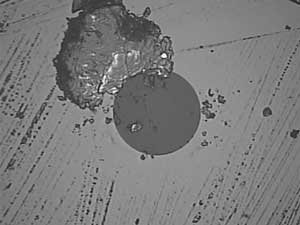 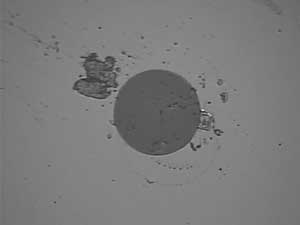 As you can see, the dirt is large compared to the size of the fiber (dark gray), and the core (not visible here) is only 9/125 of the overall diameter of the fiber! More on cleaning. See Product News below for links to vendors of fiber cleaning products. See news about Fiber Optic Cleaning Videos on YouTube by ITW Chemtronics below. Measurement Uncertainty: Everyone testing fiber optics should understand that every measurement has some uncertainty - whether you are measuring loss, length, wavelength, power, etc. Knowing that uncertainty is very important to interpreting the measurement. It's worthwhile to read and understand the issue of measurement accuracy covered in this page of the FOA Online Fiber Optic Reference Guide. Worth Reading or Watching: Fiber Optic Cleaning Videos on YouTube ITW Chemtronics has three fiber optic cleaning videos on Roundtable at FTTH Council Show “Designed for the Future” executive roundtable, an invitation-only dinner event was hosted by DSM Functional Materials at the FTTH Council Show. Attended by senior executives from telecoms, equipment and systems providers, as well as analysts and policymakers from the US, Europe and Latin America, the session generated thoughtful discussion on this and many other major issues facing the industry today. Topics for discussion at this year’s roundtable event included how innovative public and private initiatives such as Google’s Kansas City experiment and the GigU project to bring FTTH to university campuses could help FTTH realize its potential. Technological evolutions such as Cloud Computing, and their role in driving FTTH deployment, were also covered. The course of the discussion evolved into the following four major themes: Government’s role in FTTH deploymentClick here to read more. Should You Use Dry Water-Blocked Cables Near Salt Water? Here's another controversy in the fiber optic business. It seems that some dry water-blocked cables have problems with salt water affecting the speed and amount of water absorption by the super absorbent powder (SAP seems to be a new industry TLA - that's "three letter acronym" - for super absorbent powder) used in these dry water-blocked cables (DWB?). It seems that salt water performance has caused some users to not use this cable anywhere that it may encounter salt water. But according to an article by Ryan Chappell of Coats, a manufacturer of the yarns used in fiber optic cable manufacture as well as SAP, there are big differences between the absorbency of materials from different suppliers. We suggest you 1) read the article in Lightwave, 2) check out the Coats website and 3) ask your fiber optic cable manufacturer about their cable before installing it in a salt-water environment. We're Part of A $trillion Industry in the US A TIA commissioned report on “The Contributions of Information and Communication Technologies to American Growth, Productivity, Jobs and Prosperity,” (written by Robert J. Shapiro and Aparna Mathur, August 2011) finds that “ICT companies accounted for 3,535,000 jobs in 2009.” The report states that “in 2009, ICT firms contributed about $1 trillion to U.S. GDP, or 7.1 percent of GDP. This total includes nearly $600 billion in direct contributions from their own operations and more than $400 billion in indirect contributions through the benefits other sectors derived from the use of ICT.” Other highlights from the report include: “The President’s proposal to fund the development and initial deployment of a nationwide wireless broadband data and communications network for public safety agencies would lead to the creation of an estimated 100,000 new jobs in ICT industries and, over time, produce indirect or spillover benefits of an estimated $4 billion to $8 billion per year.” “Investments of $3.4 billion in a “Smart Electricity Grid” under the 2009 Recovery Act should directly produce nearly 30,000 new jobs. If the funding becomes seed money and an ICT-based Smart Grid is developed and deployed, analysts estimate the net economic benefits could range from $48 billion to $76 billion per year.” From the TIA PR. You can download the entire report at TIAonline. Wire & Cable Asia A new newsletter about the wire and cable (and fiber optic) industry in Asia is available online. See http://www.read-wca.com/ for more information. Fiber Optics In WindPower Fiber is an important communications tool for wind farms. In this webinar, you will learn some of the driving forces behind the evolution of wind power systems as well as the design challenges, specifically in the area of data communications. Solutions for high-reliability communications links using optical fiber technology will be presented. These solutions offer the galvanic isolation and electrical noise immunity required to address wind power system needs. Avago Technologies products meeting the needs of wind power system designers will be profiled. Download it for viewing. IGI Consulting Plans New Series of Government Telecom, Fiber Optics and ICT Marketing Guides IGI Consulting has initiated a project to develop a series of ten Marketing Guides to assist companies in accessing the military and government telecommunications, fiber optics, and information technologies markets. The government represents a major large and stable market. Despite pressure to reduce the government budget, there will still be a need for government to use technology to improve productivity and provide services and security. IGI Consulting has analyzed all the major government agencies responsible for buying, specifying, and investing in telecommunications, fiber optics, and information technologies. This provides the marketing manager with an independent view of the government market and saves time searching the web for the information. Here are the ten volumes: More Information. Corning Has Translated Training Documents and Videos Into Spanish Check with Corning for availability. Smart Grid The National Association of Electrical Distributors has created a nice overview of "smart grid." It covers a brief overview of the US electric power system, an understanding of why the smart grid has become a national priority, a snapshot of the various electrical components and concepts that are part of the smart grid, advice on how your business can get involved and a look at some key players who should be on your radar if they aren't already. Go to the NAEC Smart Grid website and download their Quick Start Guide. A Documentary Treasure on the History of the Internet 15 minutes of a rarely-seen BBC documentary demolish the myth that ARPAnet was inspired by nuclear war, and explain the far more intriguing truth. http://www.technologyreview.com/blog/mimssbits/26719/?nlid=4433 Searchable IGI Publication Archives Now Available as Google eBooks Information Gatekeepers Inc. (IGI), a leading international supplier of information on fiber optics and telecommunications markets and technology, has entered into an arrangement with Google to make its archives available as Google eBook. Since 1977, IGI has been publishing newsletters, conference proceedings, market research reports, and other publications focused on worldwide markets in telecommunications and fiber optics. With Google eBooks , all of these publications and studies — including previously unavailable earlier works — are now available in searchable, electronic format to market researchers, financial analysts, lawyers, governments, university researchers, libraries, and all other interested parties. Please search our new archive by visiting igigroup.com or entering search terms in the box below. The new Google eBooks of IGI publications are also the best available for reading on mobile devices. Google eBooks can be read on the Web, Android phones, iPhone, iPad, iPod touch, and supported eReaders. Learn more about our supported devices. For more information on the new Google eBooks of IGI publications please visit igigroup.com. You can search Google Books for IGI publications directly - Go here. Ensuring Distance Accuracy On OTDR Measurements By JDSU. The Victorian Internet by Tom Standage 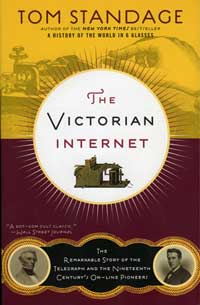 If you think the Internet has changed communications in recent years, consider the effects of the introduction of telegraphy 150 years ago. Communications went from as slow as horses, ships or trains could carry news to instantaneous! Who was the first to use it? Stock traders, of course, and low latency is still their goal! It's a good read, and you'll find out some new info on Thomas Edison! On Amazon. Broadband Properties Webinar Archives  Lots of interesting webinars, mostly on FTTH. Go here. FTTX Networks An ADC white paper on how they work and how networks are upgraded to FTTH. http://connectedplanetonline.com/images/CP-ADC3-WhitePaper-v4.pdf. JDSU Application Note On "Qualifying FTTH Network before Equipment Installation" Another great paper from JDSU covering FTTH PON networks is available for downloading. It gives an overview of FTTH architecture, cleaning connectors then testing the cable plant with OTDRs and OLTSs. This paper will help you understand why OTDRs can be confusing on PONs! Best Practices For Wireless Backhaul Network Upgrades Joan Engebretson, Contributing Editor of Connected Planet has written a very good overview of how fiber is essential to the operation of cellular wireless systems. Everybody probably knows that fiber is used to connect towers into the telecom network - they call it backhaul - but her article also covers the new appliations to replace bulky, heavy, lossy coax up the tower to the antennas. http://connectedplanetonline.com/images/CP_ADC2_WhitePaper.pdf. Fiber Optic Safety Poster We've had numerous requests to reprint our guidelines on safety when working with fiber optics, so we have created a "Safety Poster" for you to print and post in your classroom, worksite, etc. We suggest giving a copy to every student and installer. Corning now offers videos on  .
Lots of interesting videos, some technical, some sales, but all good
information. .
Lots of interesting videos, some technical, some sales, but all good
information.US Conec's videos on cleaning fibers - show's the results of proper cleaning. Webinars of Interest Broadcast Engineering Magazine - Fiber Optic Testing FOA President Jim Hayes presents an overview of fiber optic testing for all applications. Available on Demand. Sign up here. Multimode Fiber Trends from TIA's Fiber Optics LAN Section Ryan Chappell, Draka Communications, looks at the evolution of multimode fiber, examines its current usage and shares predictionson its future Available on-demand at: http://www.brighttalk.com/webcast/7182/play OSP Magazine Webinars OSP Magazine (OSP as in outside plant telco) is now offering a number of interesting webinars that cover fiber topics, including network design and specialized components. http://www.ospmag.com/events/web/ Multimode Fiber Characterization Launch Condition Considerations - new ap note from JDSU JDSU Reference Guide to Fiber Optic Testing – Volume 2 Published  The second volume of the JDSU series on fiber optic testing has been published. Volume 1 focused on Basic Fiber testing and Volume 2 is geared toward fiber optic installers, project managers, telecom technicians and engineers who need to understand fiber networks. Volume 2 also covers Chromatic Dispersion, Polarization Mode Dispersion, Attenuation Profile and Fiber Link and Network Characterization. A 3rd volume, a glossary of fiber optic terms, is also available for download. This is a "MUST HAVE" for all fiber optic techs. Download your free copies here. We used this book as one of our references in creating a new page in the FOA Online Reference Guide on chromatic dispersion (CD) and polarization-mode dispersion (PMD). Careers in Fiber Optics: Brian Smith. A 1998 book on fiber optic jobs is a bit dated, but a free overview is on Google Books and worth a look at it online. Dirt! As much as 70% of the problems associated with deploying fiber to the home result from something as simple as dirty connectors according to JDSU. Telephony Online. US Conec's videos on cleaning fibers - show's the results of proper cleaning. Good Technical Websites American Polywater (http://www.polywater.com/) has one of the best technical website for cable installers. Here is a rundown on some new material on their site. Cable Installation using "Push" or "Push/Pull" Polywater's new Pull-Planner™ 3000 Software allows a "pushing force" variable in pulling tension calculations. Read a White Paper that quantifies the push contribution and compares calculation results to field experience. -- http://www.polywater.com/pushing.pdf Pulling Cable Through Water? Read a Product Spotlight on Polywater® + Silicone™, Polywater's new generation underground lubricant. Continued reduction of friction when pulling through water is only one of the unique features of this lubricant. -- http://www.polywater.com/NNNBSL.pdf Check out their website, especially “Videos,” “Engineer’s Corner” and “Calculators.” http://www.polywater.com/NNNBSL.pdf  " Heard on the Street" is a monthly online newsletter from Frank Bisbee of Communications Planning Corporation that covers the telecommunications and cabling businesses. Each month includes news from manufacturers, trade associations and professional societies like the FOA. You can read the current issue and back issues online.  JDSU has announced the See the Light webinar series, a four-part program designed for anyone involved in the installation, maintenance, and repair of fiber optic systems. It begins with fiber inspection and cleaning and then covers the basics of fiber testing. The webinar series then continues with the more advanced optical time-domain reflectometer (OTDR) and fiber local area network (LAN) testing challenges. More information on the series. IGI is offering a series of webinars on topics of interest to those in the communications industry. You can join them live ir download from the archives. IGI WEBINAR ARCHIVES UP AND RUNNING - VISIT TELECOMBRIEFINGS.COM TO DOWNLOAD! IGI, a major market research and technology reporting company (the "Active Optical Cables" below) is offering a a free one year subscription to one of our fiber optics newsletters to FOA members. All they have to do is to send IGI an e-mail stating which newsletter they would like to get. See http://www.igigroup.com/nl.html for a listing of IGI Newsletters. A Fiber Optic Tester In Your Pocket? (See the video on Yes! The camera in your cell phone is sensitive to infrared light - lots more than your eye - and can detect light in an optical fiber or from a transmitter. Chris Hillyer,CFOT/CFOS/I, Master Instructor, Northern California Sound & Communication JATC sent us some photos showing how this works and the following description.  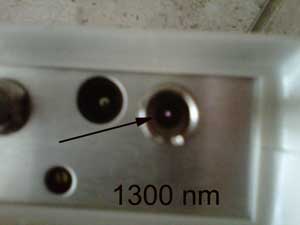 "Your cell phone camera's image sensor can read IR light. It uses this technology to help take pictures at night. In the advanced audio and CCTV field they have been using the smart phone camera to trouble shoot problems in IR communications. The human eye cannot see the IR light emitted by let’s say a remote control. Well up until now we would always say that the remote is out of batteries, or either the IR transmitter or IR receiver was not working properly. Now we can use your smart phone camera to see the IR light emitted by the IR transmitter. All you have to do is turn on your camera function on your smart phone and hold it up the remote control and push any button. The cameras screen will show the IR light. Now back to Fiber Optics. If you follow the same principals of the last paragraph, let’s say you wanted to check if a fiber port was energized. You can either use the card that is supposed to show you in a few seconds that the port was hot. Or you could plug in your meter, in this case it takes some time to find the card or if you don’t have your meter handy. Just pull out your smart phone turn on the camera and hold it over the port. If it is hot you will see a bluish white dot in the fiber bulk head (see attached pictures)." We tried this ourselves and found our camera phone very sensitive at 850 nm but as expected less so at 1300 nm, like all semiconductor detectors. Our phone could still see 1300 nm sources at around -20 dBm, making it very useful even for LED sources, and of course, perfect for lasers. OFSTP-14 Update OFSTP-14 is the TIA standard for testing installed multimode fiber optic cable plants which has been around more than 20 years and is the one TIA standard probably most familiar to contractors and installers. The TIA has adopted IEC 61280-4-1 as the replacement of OFSTP-14. Most of the two documents is the same, with some important exceptions.
We are creating a web page to explain the differences and will give you a link shortly. In the meantime, continue testing as usual.
Handheld OTDR 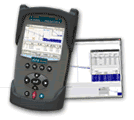 Advanced Fiber Solutions has introduced a new compact portable OTDR that offers high resolution (to 1m) and light weight (1.6 pounds, 0.72 kg) plus numerous wavelength and range options. Here is more information. Fiber Optic Coil-Cords  JEM Cables of Franklin, MA, makes coil cords of optical fiberthat are used for industrial and military uses. They also make armored (really armored - not just to prevent rodent damage) cables. www.jemcables.com AFL SimpleView™ Enables Fiber and Connector Inspection Using Laptops 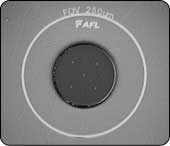 AFL is launching AFLSimpleView, software that permits technicians to use existing field-issued laptops, tablets and palmtops as a fiber inspection system by simply plugging in a NOYES® DFSI FiberScope. Compatible with Windows® XP and Windows® 7 operating systems. You can download the software from the AFL website if you already have a DFSI Fiberscope. Protecting Pedestals From Rodents Pedestals and underground vaults can be damaged by rodents who come up through the base and damage cables. Uraseal "Drain N'Seal" foam deters mice from taking up residence in your pedestals. They have some good videos on using their product. A Cable Tie That's Fiber Friendly We're always warning installers not to tighten cable ties too tightly around fiber optic cable (or UTP copper cable either!) A better choice is the hook and loop fastener ties (Velcro is one trade name), but there is another type, the Mille-Tie. It's an open tie that can be used at any length, then cut off and the remainder used also. Take a look a the video to see how it works. Mille-Tie Video: http://www.youtube.com/watch?v=QPVTQGKmcvE The FOA has updated its Reference Guide page on bend-insensitive fiber. Benchtop Connector Cleaner 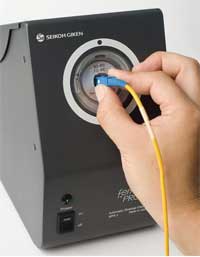 FerrulePro™ is the world’s first fully automated benchtop fiber connector cleaner for laboratory and cable production environments. It automates the final cleaning of all types of terminated fiber products, a critical task where performance once depended largely on the production line worker’s skill. Fiber connectors can be cleaned in 3 seconds cycle - eliminating the need for re-cleaning after post production inspection. More.
They're still being used for high power laser delivery - up to 80-100W! Seikoh Giken has even introduced some new ones. Used Test Equipment – Buy or Sell http://www.testequipmentconnection.com/ Have you read the FOA Tech Topics on Cleaning? More links on cleaning: Cleantex Alco Pads Testing FTTH JDSU shows how to test a PON with an OTDR: http://www.jdsu.com/other-literature/PON-OTDR_fop_an_ae.pdf
|
What Is The FOA? Hear FOA President Jim Hayes tell the FOA Story in a 2-part interview by Sound & Video Contractor Contributing Editor Bennett Liles. It tells about the FOA history, goals and achievements. Part 1: http://svconline.com/podcasts/audio/fiber_optic_association_part1/index.html. Part 2 http://svconline.com/podcasts/audio/inside-fiber-optic-association2-0924/index.html. |
|
Digging Safely (Read the FOA Tech Topic) There is a toll-free "call before you dig" number: 811 See www.call811.com for more information National Fiber Optic Protection Summit: By the "811" group. March, 2008 in Vegas.
|
|
|
Employment New FOA Jobs Website We get many questions from CFOTs, students at FOA-Approved schools and others contemplating getting into the fiber optic business regarding jobs in fiber optics - and how to find them - so we’ve created a new web page to share some information we've gathered about jobs in our industry. The information is designed to help you understand what jobs are available in fiber optics, how to find them and apply for them. While the overall economy is pretty bad - you've probably heard that there are 5 times as many people unemployed in the US as there are jobs available, telecom is a bright spot - broadband is a major focus of stimulus spending in the US and countries around the world are building fiber networks as fast as possible. Even wireless companies have to build fiber for their backhaul. Cities are installing fiber linked surveillance cameras and smart traffic lights. Fiber is the link making Smart Grid possible. Companies like Allied Fiber are building large private networks. Telecom is one of the fastest growing businesses worldwide. If you are looking for a job in fiber optics, here is the FOA's guide to jobs. The FOA has created a group on A list of 10 ways to get your resume noticed from Marketplace on NPR Jobs Created As Part of Stimulus-Funded Projects The federal government is spending 7.2 billion dollars on the Broadband Technology Opportunities Program. This money is working it's way into the economy and hopefully will provide jobs. You can track recovery dollars and look for job opportunities on this website: www.recovery.gov Go to "opportinities" link then "jobs". You will see a section “find recovery jobs” – enter “fiber optic jobs California” or wherever you are and review what comes up. One of the projects funded by stimulus money is the1100 mile network of Maine Fiber Company Inc. which has selected nextGen Telecom Services Group Inc. as the installation contractor. CFOTs: NextGen has a link on their website for applying for jobs Job Openings Senior Electrical Engineer “da Vinci” Surgical Equipment, www.intuitivesurgical.com (October, 2011) Job Location: Sunnyvale, CA Please email me directly at maryjane.dow@intusurg.com Primary Function: The successful Senior Electrical Engineer will lead the identification, sourcing, development, and integration of novel electro-optical sensing systems for surgical robots. The candidate must be able to identify and evaluate new candidate technologies, work with vendors to customize hardware and software to meet specific requirements, and drive robust technical solutions into production. He or she must excel in a high-energy team environment and be capable of making sound decisions when faced with the time pressures and incomplete information typical of new product development. The successful candidate must have outstanding technical depth in relevant areas, but be as comfortable leading and specifying as designing. DESCRIPTION Roles and Responsibilities This position has responsibility and authority for: · Comparing and evaluating available sensing technologies · Determining requirements for next generation sensing technologies · Developing vendor technical relationships and project managing vendors · Specifying and leading the development of additional hardware and software components as needed · Integrating, calibrating, and bench testing newly developed sensing systems · Supporting productization of integrated sensing systems on new and existing robot platforms · Documenting, preparing and reviewing patent submissions ADDITIONAL REQUIREMENTS Competency Requirements Competency is based on: education, training, skills and experience. In order to adequately perform the responsibilities of this position the individual must: · Masters’ degree in EE, Physics, or related field required · Minimum of five (5) years of experience taking successful products to production · At least eight (8) years of experience with: · Electro-optical and bench instrumentation design/development · Electronic and optical test & measurement instruments · Analog and digital signal processing hardware and algorithms · Lasers, optical fibers and connectors, integrated optical devices and optical materials · Familiarity with telecom technologies and standards, particularly relating to fiber optics · Background in analytical physics/optics · Comfortable with scripting/programming in common engineering environments · Experience managing vendors and projects · A passion for creating robust and reliable products Sales (October, 2011) Diamond USA, a leading manufacturer of Fiber Optic Solutions seeks a Regional Sales Representative for the New England Territory. Are you a highly motivated, outgoing and dynamic sales professional with the technical aptitude, to discuss fiber optic applications/solutions to meet our customer’s needs in the following markets: Medical, Industrial, Telecom, Military, and Aerospace? Successful candidate will be responsible for expanding our customer base as well as maintaining existing customers. This successful candidate will also evaluate customer’s applications, recommend solutions, conduct demonstrations/ presentations to end users, and close the sale. Requirements: § Minimum 3 year’s field sales experience in fast- paced technical components and system sales environment. Fiber optics a plus. § 4 year degree in Engineering, Business or Life Science. § Strong presentation and public speaking skills § Account planning and pipeline management experience § History of exceeding sales quotas § Ability and willingness to travel Company offers a Competitive Base Salary, Commission, Car Allowance, Health, Dental, Short/Long Term Disability, Life Insurance and a 401K. If this is the challenge you are looking for, send resume with salary history/requirements to: Diamond USA, Inc. Human Resources 27 Industrial Avenue Chelmsford, MA 01824 Job No. 101711 Email: hr@diausa.com Director, Engineering, Fiber Optics (Sept, 2011) A major global business unit of a $12+ B has an opportunity for a seasoned engineering leader to manage the Engineering & Technical organization. The Director, partnering with a newly hired leader of Fiber Optics, will be a key player in establishing a solid foundation of the fiber optics business moving forward. Reporting to the Vice President for the Fiber Optics business within the $1B business, the Engineering leader will have direct responsibility for all development and sustaining engineering, for the advanced fiber optics lab, for the Manufacturing Development Engineering group including Automation, Advanced Quality, Industrial Engineering and Materials Planning and for a customer-focused engineering team. Qualifications and experience: Deep knowledge of the fiber optics industry and technology Subject matter expert in Fiber Optics with experience in active & passive fiber optics as well as photons, engines and fiber architecture Knowledge in all aspects of Opto-Electronic packaging including Designing and Manufacturing of Opto -Electronic components including Vcsels, Photo Diodes and IC's Global engineering leadership experience Strong leadership skills including communication, talent evaluation and development – an outstanding technical leader with strong interpersonal and management skills Bachelors degree in engineering required, Masters preferred Excellent customer interface and relationship building experience with ability to identify customer needs and transform them into new product offerings. Willingness to travel frequently, and as necessary, to support a global engineering organization with significant presence in Harrisburg, PA; Phoenix, AZ; Den Bosch, The Netherlands; Stockholm, Sweden and Shanghai, China ~~~~~~~ Sr. Manager, Fiber Automation & Advanced Manufacturing (8-11) A major global business unit of a $12+ B has an opportunity for a seasoned Advanced Manufacturing professional with strong accomplishments in automating manufacturing processes. The Sr. Manager, partnering with the Director of Engineering for Fiber Optics and the VP of Operations, will be a key player in enabling significant growth in our fiber optics business – an area identified as one of the top investment priorities. Reporting to the Director of Global Automation with a strong dotted line to both the Fiber Engineering Director & VP Fiber Optics Operations, the Senior Advanced Manufacturing Manager will have responsibility for transitioning our current fiber production into a higher volume enterprise to enable the organization to meet anticipated demand in the market. Qualifications and experience: Knowledge and experience transitioning manual and small-batch production to high volume manufacturing through automation. Knowledge of the fiber optics manufacturing significant advantage; Knowledge of automation in Electronics manufacturing required Experience with active & passive fiber optics Strong project management skills Bachelors degree in Engineering required Ability to influence across an organization Willingness to travel frequently, and as necessary, to support a global manufacturing and fiber optics organization with significant presence in Harrisburg, PA; Phoenix, AZ; Den Bosch, The Netherlands; Stockholm, Sweden and Shanghai, China Contact: Steve Lavner Vice President and Senior Associate Diversified Search t. 212-542-2586 c. 917-885-4409 f. 212-542-2574 Steve.Lavner@divsearch.com www.diversifiedsearch.com Instructors For FOA CFOT Courses (8-11) Educational Resources needs instructors in several areas around the US including TX and DC. Contact Heather Blake Educational Resources, Inc., 703-904-1800 x 104, heather@educationalres.com OSP Fiber Inspector (8-11) Growing telecommunications company in need of a outside plant Fiber Inspector for the southern Eastern Shore for a 2 to 2 ½ year contract. Hourly pay will be commensurate with experience Duties include: Construction OversightQuality Verify Redlines/As-builds for turn over to Project ManagerSafety Ensure proper traffic controlInternal Task Management and support Support for internal management and corporate development tasks For more information, please call Grant Toomey at 410.573.0003 – or you can reach him via email at gtoomey@corporatebrokers.com Grant Toomey Corporate Brokers, LLC Strategic Staffing Solutions 170 Jennifer Road Suite 230 Annapolis, Maryland 21401 410-573-0003 410-573-9275 Fax www.corporatebrokers.com EM4 (8-11) EM4 designs, develops and manufactures state-of-the-art, ruggedized, optoelectronic components and packages for the Defense, Aerospace, Life Science, CATV, Telecommunication and Industrial markets. EM4 is part of a global group of specialized optical companies that form Gooch & Housego. Lead Engineer : Fused Technology EM4 is seeking an experienced Lead Engineer to join our team to work on the transfer and operation of the semi automated Fused Coupler capability in conjunction with Gooch &Housego (G&H) located in Torquay, UK. The role involves practical hands on product manufacture, development and first line technical support together with a full suite of project management skills to effectively communicate across G&H sites and with external customers. You will be responsible for learning the fused coupler product line in the UK and moving the manufacturing processes and equipment to the US. Engineering Program Manager EM4 is seeking a talented Engineering Program Manager with a proven track record of managing complex programs to a timely and cost effective conclusion within the Defense Industry. The ideal candidate will have small company experience with fiber optics, photonics, electro-optics, lasers and optics; and an established contact base from which to draw suppliers and customers. The position is headquartered out of the Bedford, MA office of EM4. Quality Manager EM4 is seeking an experienced Quality Manager to join our team to work on implementing the necessary quality management systems to enable AS9100 accreditation. As the AS9100 standard is a fundamental requirement within the markets we operate, it will enable further growth within our product ranges; optoelectronic, fiberoptic, electronic and RF components and subsystems. Additionally, it will ensure the necessary control systems are in place in support of future integration opportunities with our corporate company Gooch & Housego. Package Design Manufacturing Engineer EM4 is seeking a talented Package Design Engineer to join our team to work on new and existing projects and programs. The Package Design Engineer will provide optomechanical design and integration engineering for optoelectronic, fiberoptic, electronic and RF components and subsystems. FOR ALL POSITIONS US Citizen or Green Card Holder required. Outstanding compensation and benefits package to all employees. EM4, Inc., 7 Oak Park Drive, Bedford, MA 01730 Please submit your resume to jobs@em4inc.com FOA lists jobs and contracting opportunities on our LinkedIn group. CFOTs are invited to join. Do listings in the FOA Newsletter Work? Here's feedback: "We did great! We have over 15 interviews next week." "Your newsletter generated a significant number of applicants and we have filled the position." |
|
Which of the following is generally NOT a problem when separating a source and power meter after calibrating "0 dB loss" reference to test a cable plant with the instruments at each end of the cable plant in different locations? A. Source warm-up time B. Source stability with battery condition C. Coupling variability when removing/inserting launch reference cable at source D. Meter variability See the Sept. answer below Go here to answer the question. Be sure to enter the month of the quiz!
Your Name, CFOT® - It pays to advertise! The FOA encourages CFOTs to use the logo on their business cards, letterhead, truck or van, etc. and provides logo files on this site for that purpose. But we are also asked about how to use the CFOT or CFOS certifications. Easy, you can refer to yourself as "Your Name, CFOT" or "Your Name, CFOS/T" for example. Feel free to use the logo and designations to promote your achievements and professionalism! |
|
Remember To Renew Your Certification ! Remember
to renew your FOA certification. All current CFOTs have a ID Card with
their certification data and we keep a database of current CFOTs to
answer inquiries regarding your qualifications if needed. You must be a
current FOA member and CFOT to participate in our online
database of installers, contractors, technicians and consultants.
If you forgot to renew, use the online application
form to renew NOW! You can now renew your FOA certification online - and get an extra month free. Details here. |
|
|
September 2011 The article above covered the different OTDR traces you get with cleaved or broken fibers. What would the end of the trace look like if the far end connector was an APC type? A. About the same as a cleaved fiber B. About the same as a broken fiber C. No reflectance at all - the angle of the endface of an APC connector stops reflectance D. None of the above August 2011 What was the first application for which VCSELs were used? A. Video over MM fiber B. Gigabit Ethernet was the correct answer. C. Fibre Channel D. SANs See the FOA Reference Guide for more info. Gt (C)1999-2011, The Fiber Optic Association, Inc. |